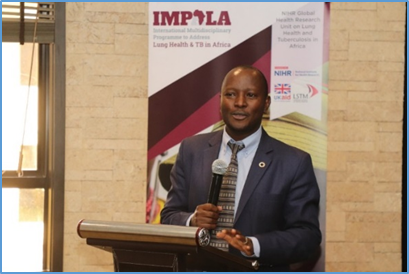Paul* has a nervous cheeky smile as he refers to himself as “a walking pharmacy”; a reference his friends gave him due to the fact that he always has a variety of medicine with him. His happy demeanor hides years of pain and numerous hospital visits following his lung collapse and its eventual surgical removal. Paul now functions with one lung and experiences complications as a consequence, such as occasional breathlessness.

What happened? How did he get here? Paul was diagnosed with tuberculosis (TB) in 2012. He diligently took his daily TB medication for six months and was successfully discharged from the chest clinic after completing therapy. About four years later, Paul started having shortness of breath and difficulty breathing. After a series of tests and numerous hospital visits, he was diagnosed with pneumothorax (collapsed lung). A pneumothorax occurs when air leaks into the space between the lung and chest wall, pushing on the outside of your lung and causing your lung to collapse. During this time, he was diagnosed with TB again and put on a rigorous treatment regimen once again. For Paul, just like many TB survivors, life after TB may never be the same; there may be physical, physiological, social and psychological effects of TB that may continue long after treatment. Paul has a physical effect, post-TB lung disease.
Post-TB lung disease is common, varying in severity and impact on the quality of life. However, there is a lot we do not know about post-TB lung disease. Kenya, a country with a high burden of TB-both drug-sensitive and drug-resistant had 96,478 patients notified to have TB in 2018. How many of these will end up having post-TB lung disease? What are the likely conditions they will present? How will we make the diagnosis? Which department will be responsible for their care? What treatment will they require? How much will their care cost? Who will pay for their management? Will their sources of livelihood be affected? The questions continue with very few answers…
On 3rd February 2020, Kenya held the 1st Post TB lung disease stakeholders forum to raise awareness of post-TB lung disease and to deliberate on how to tackle the issue. The stakeholder interface was hosted by the African Institute for Development Policy (AFIDEP) and the Division of National Tuberculosis, Leprosy and Lung Disease Program in Kenya as part of the four year NIHR-funded International Multidisciplinary Programme to Address Lung Health and TB in Africa (IMPALA). There were 44 attendees with representation from Ministry of Health- Department of Strategic National Health Programs, Division of Tuberculosis, Leprosy and Lung Disease Program, University of Nairobi, Respiratory Society of Kenya, KEMRI, Kenyatta National Hospital, Moi Teaching, and Referral Hospital, STOP TB Kenya, AFIDEP, Centre for Health Solutions-Kenya among others. Dr. Kibachio, the Head of Strategic National Health Programs-Kenya, gave opening remarks challenging the teams to address the post-TB story, “TB is one of the historic diseases in Kenya, however, its story ends with cure yet that is the beginning of another story which is unfortunately not captured by the program, ‘the Post TB’ story”. Lung health expert and former president of the Union, Dr. Chakaya, noted in his presentation that: Over 60% of TB patients still have symptoms at the end of TB treatment, >80% have radiological (X-ray or CT scan) findings, >30% have lung function abnormalities and >40% have bronchiectasis. Patients may have persistent symptoms as well as impaired and/or faster decline in lung function.
This limited evidence demonstrates that Post-TB lung disease is a priority that needs attention. What do we need to do? Firstly, we need to quantify the problem. Such data will be critical when setting the post-TB agenda. Next, we need to develop approaches to tackle the problem, including preparing health systems to support patients like Paul. This includes ensuring post-TB lung disease management is covered under universal health coverage as well as offering patients social protection. Furthermore, there is a need to consolidate research around Post-TB lung disease so that we can address the information gaps around the issue, raise more awareness about it and build a community of experts as suggested by Executive Director of the African Institute for Development Policy, Dr. Eliya Zulu. Internationally, the 1st post tuberculosis symposium was held on 22nd – 23rd July 2019 in Stellenbosch, South Africa(1). As we aim to ensure a world free of TB as envisioned by the END TB strategy(2) through reaching 90% of people with TB, reaching 90% of the key populations and achieving 90% treatment success; I echo the sentiment of Harries et al on adding a 'fourth 90'-Ensuring that 90% of all people successfully completing treatment for TB can have a good health-related quality of life'(3).
A quote from Dr. Chakaya summarizes the stakeholders meeting consensus “Let’s start somewhere and do something with the little we know!”
References
1.First International Post Tuberculosis Symposium 2019. Stellenbosch, South Africa; 2019.
2.WHO. The END TB Strategy. Geneva: World Health Organisation; 2015.
3.Harries AD, Dlodlo RA, Brigden G, Mortimer K, Jensen P, Fujiwara PI, et al. Should we consider a 'fourth 90' for tuberculosis? Int J Tuberc Lung Dis. 2019;23(12):1253-6.